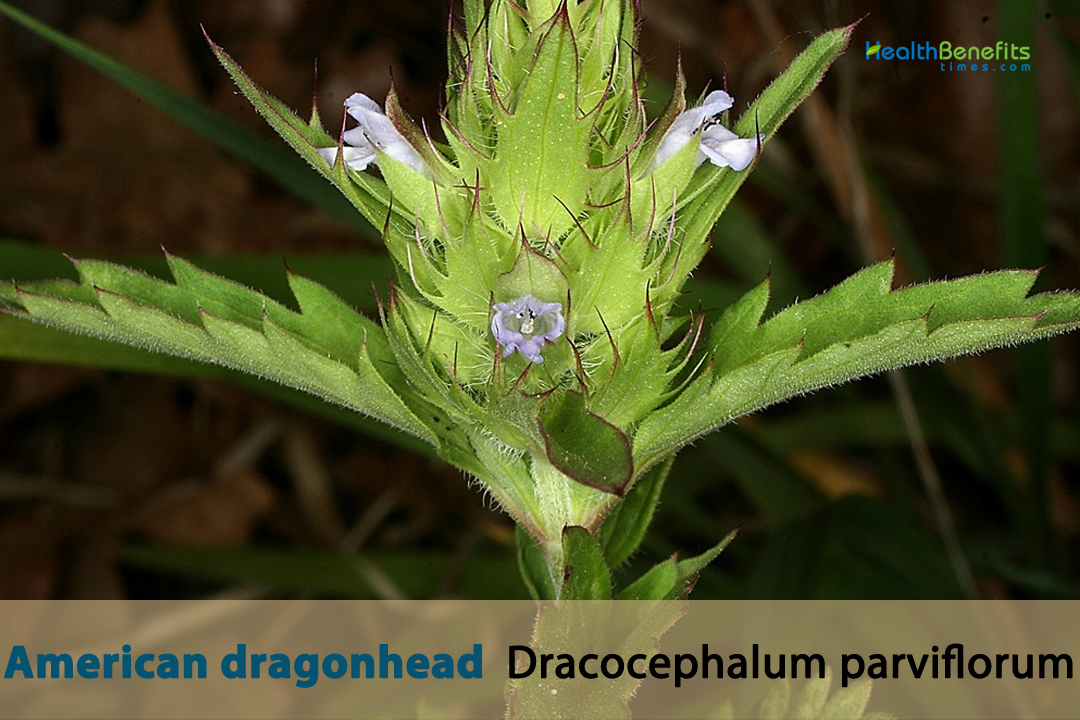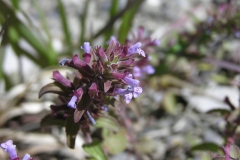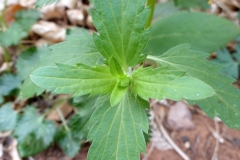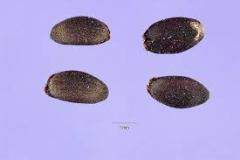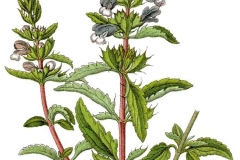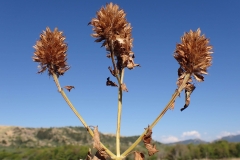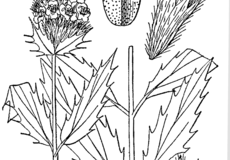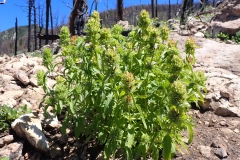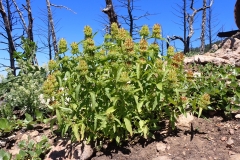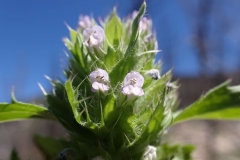The nomenclature of the genus Dracocephalum is composed of two Greek words: Draco (ΜρνϿωv), denoting the dragon, and Cephalum (κεϳαλζ), signifying the head. Denoting the form or visual presentation of the inflorescences or groupings of flowers, “Dracocephalum” can be interpreted as “dragon’s head.” The name of this species originates in Latin. The definitions of parvi and florum are “small” and “flower,” respectively. Consequently, parviflorum indicates that the blossoms of this species are small. American dragonhead has a historical record of indigenous peoples employing it for medicinal purposes. It was utilized by some Native American cultures to treat a variety of conditions, including fevers, colds, and digestive issues. Chemical compounds present in the plant potentially possess mild medicinal properties.
American Dragonhead Facts
| American dragonhead Quick Facts | |
|---|---|
| Name: | American dragonhead |
| Scientific Name: | Dracocephalum parviflorum |
| Origin | Eastern and central North America |
| Colors | Usually brown or dark in color |
| Shapes | Elongated and cylindrical capsules |
| Taste | Slightly bitter and herbaceous |
| Major nutrients | • Essential Oils • Flavonoids • Phenolic Compounds • Terpenoids |
| Health benefits | Digestive Aid, Respiratory Health, Antioxidant Benefits, Stress Reduction, Pain Relief, Antimicrobial Effects, Immune Support, Cardiovascular Health, Skin Health |
| Name | American dragonhead |
|---|---|
| Scientific Name | Dracocephalum parviflorum |
| Native | Eastern and central North America. Its native range extends from Canada in the north to Mexico in the south and from the western United States to the eastern United States |
| Common Names | American dragonhead, Rocky Mountain false dragonhead, False dragonhead, Prairie dragonhead, Parviflorum dragonhead, Blue dragon’s head, Smallflower dragonhead, Rocky Mountain dragonhead, Blue dragonhead, Wild mint |
| Name in Other Languages | Arabic: Ra’s altaneen al’amriki (رأس التنين الأمريكي) Assamese: Amerikan dragonhed (আমেৰিকন ড্ৰাগনহেড) Bengali: Amerikan Ḍrāganhēḍēra māthā (আমেরিকান ড্রাগনহেডের মাথা) Bulgarian: Amerikanska glava na drakon (Американска глава на дракон) Chhattisgarhi: Amerikan ḍraiganahed (अमेरिकन ड्रैगनहेड) Chinese: Měizhōu lóngtóu (美洲龙头) Croatian: Američka Glava Zmaja Czech: Americká Drakonohlava, Americká Drakohlava Danish: Amerikansk Dragehoved, Storbægret dragehoved Dutch: Amerikaanse Draakshoofd English: American Dragonhead, Dragonhead, American Dragon-Head, Dragonhead Mint, Small-Flowered Dragonhead, False dragonhead Estonian: Ameerika Draakonipea Filipino: Ulo ng American Dragonhead Finnish: Amerikanlohikäärmeen pää, Amerikanlohikäärmepää, Amerikanampiaisyrtti French: Tête de Dragon Américaine, Dracocéphale d’Amérique, Tête-de-dragon d’Amérique, Dracocéphale parviflora, dracocéphale à petite fleur, dracocéphale de Virginie, German: Amerikanischer Drachenkopf, Kleinblütiger Drachenkopf, virginischer Drachenkopf Greek: Amerikanikí kefalí drákou (Αμερικανική κεφαλή δράκου) Gujarati: Amarikan ḍreganaheda (અમેરિકન ડ્રેગનહેડ) Hindi: Amerikan draiganhed (अमेरिकन ड्रैगनहेड) Hungarian: Amerikai Sárkányfej Italian: Testa di Drago Americano Japanese: Amerikandoragonheddo (アメリカンドラゴンヘッド) Kannada: Amerikan ḍryāganhed (ಅಮೆರಿಕನ್ ಡ್ರ್ಯಾಗನ್ಹೆಡ್) Kashmiri: Amrikan Ḍraigan Heḍ (امریکن ڈریگن ہیڈ) Konkani: Amerikan ḍræghanhed (अमेरिकन ड्रॅगनहेड) Korean: Migug-yong meori (미국용 머리) Lithuanian: Amerikos Drakono Galva Latvian: Amerikāņu Pūces Galva Maithili: Amerikan ḍraiganahed (अमेरिकन ड्रैगनहेड) Malay: Kepala Naga Amerika Malayalam: Amērikkaṉ ḍrāgaṉheḍ (അമേരിക്കൻ ഡ്രാഗൺഹെഡ്) Manipuri: Amerikan ḍrẏāganahēḍ (আমেরিকান ড্র্যাগনহেড) Marathi: Amerikan ḍręḳanhēḍ (अमेरिकन ड्रॅगनहेड) Nepali: Amerikan ḍryāganahed (अमेरिकन ड्र्यागनहेड) Norwegian: Amerikansk Dragehode Odia: Āmerikān ḍrāganahēḍ (ଆମେରିକାନ ଡ୍ରାଗନହେଡ) Polish: Amerykańska Głowa Smoka, Amerikaanse Drakenkop, pszczelnik drobnokwiatowy Portuguese: Cabeça de Dragão Americano, cabeça-de-dragão Punjabi: Amarīkan ḍraiganahaiḍ (ਅਮਰੀਕਨ ਡ੍ਰੈਗਨਹੈਡ) Romanian: Cap de Dragon American Russian: Amerikanskaya golova drakona (Американская голова дракона), Zmeegolovnik melkotsvetkovyj (Змееголовник мелкоцветковый) Sanskrit: Amerikan dragōnhed (अमेरिकन् द्रगोन्हेड्) Santali: Amerikan ḍraiganahed (ᱯᱷᱨᱤᱮᱥᱤᱱ ᱯᱟᱨᱤᱤᱱᱟ) Serbian: Američka glava zmaja (Америчка глава змаја) Sindhi: Amrikan Ḍraigan Heḍ (امريڪين ڊريگن هيڊ) Slovak: Americká Drakovka Slovenian: Ameriška Zmajeva Glava Spanish: Cabeza de Dragón Americano, Cabeza de Dragón de América del Norte Swahili: Kichwa cha Joka la Amerika Swedish: Amerikansk Drakonshuvud, Amerikansk drakblomma Tamil: Amerikka ṭirākaṉheṭ (அமெரிக்க டிராகன்ஹெட்) Telugu: Amerikan ḍrāganhed (అమెరికన్ డ్రాగన్హెడ్) Thai: H̄ụ̂ mạngkrr x æmrikạn (หัวมังกรอเมริกัน) Tulu: Amerikan ḍryāgan hed (ಅಮೇರಿಕನ್ ಡ್ರ್ಯಾಗನ್ ಹೆಡ್) Turkish: Amerikan Ejder Başlığı Ukrainian: Amerikansʹka holova drakona (Американська голова дракона) Urdu: Amrikn ḍriḳan heḍ kā sir (امریکن ڈریگن ہیڈ کا سر) Vietnamese: Đầu Rồng Mỹ |
| Plant Growth Habit | Herbaceous perennial plant |
| Growing Climates | Meadows, prairie, open woodlands, stream banks, wetlands, roadsides, disturbed areas, banks of rivers, streams, and other water bodies, montane, foothill habitats, coastal regions, dry, rocky or gravelly calcareous soils, forest clearings, parklands, boreal forest and stream banks |
| Soil | Well-drained soil is essential for American dragonhead. It can tolerate a range of soil types, including sandy, loamy, and clay soils, as long as they do not become waterlogged. Ensure that the soil pH is in the neutral to slightly alkaline range |
| Plant Size | 1 to 3 feet (approximately 30 to 90 cm) tall and 1 to 2 feet (approximately 30 to 60 cm) in width |
| Root | Starts its growth with a primary root, which emerges from the seed |
| Stem | Slender, upright stems that may be square or slightly ridged |
| Bark | Doesn’t have true woody stems or traditional bark |
| Leaf | Lance-shaped and often have serrated edges. They are typically medium to dark green in color and can range from 1 to 3 inches (2.5 to 7.5 cm) in length |
| Flowering season | May to June |
| Flower | Showy, tubular flowers that are arranged in dense spikes at the top of the stems. The flowers can be blue, purple, pink, or lavender and have a two-lipped appearance |
| Fruit Shape & Size | Elongated and cylindrical capsules that is divided into multiple segments, usually four, each containing one or more seeds |
| Fruit Color | Usually brown or dark in color |
| Seed | Ovoid or oblong in shape, about 1 to 2 mm long with a slightly flattened appearance |
| Flavor/Aroma | Pleasant, minty or herbal fragrance |
| Taste | Slightly bitter and herbaceous |
| Plant Parts Used | Leaves and Roots |
| Propagation | By Seeds, division, stem cuttings, rhizome cuttings |
| Lifespan | About 2 to 5 years |
| Season | June to August |
| Major Nutrition |
|
| Available Forms |
|
| Health benefits |
|
Plant Description
The typical dimensions of an American dragonhead herbaceous perennial are one to three feet (30 to 90 cm) in height and one to two feet (30 to 60 cm) in girth. The plant’s distribution encompasses a variety of ecological niches, including but not limited to meadows, prairie, open woodlands, stream banks, wetlands, roadsides, disturbed areas, montane and foothill habitats, coastal regions, dry, rocky or gravelly calcareous soils, forest clearings, parklands, boreal forests, and stream banks. Soil with adequate drainage is critical for the growth of American dragonhead. Soils of various varieties, such as loamy, clay, and sandy soils, are not detrimental to its condition, provided they do not become saturated. Ensure that the pH of the soil is between neutral and marginally alkaline.
Certain Native American communities have employed botanical components as therapeutic agents to address a wide range of ailments. The foliage emits a fragrant mint scent and possesses culinary utility. They are suitable for use as a seasoning in beverages, salads, and more. Nevertheless, exercise caution when utilizing them, as their flavor can become quite potent. It is essential to note, however, that the plant should not be ingested without proper instruction, as improper use can render it toxic. Although the plant is not classified as endangered, it is susceptible to habitat loss and invasive species, just like many native species. Native plant conservation and protection is essential for preserving biodiversity and ecosystem health.
Roots
The American dragonhead develops from the embryo, where a primary root emerges. Secondary roots begin to develop as the plant reaches maturity; these roots radiate off from the primary root. The function of these roots is vital: to extract nutrients and water from the soil. Rather than a single large taproot, the plant’s fibrous root system is typically composed of numerous slender, branching roots. Root filaments are minute structures that envelop the roots. These hair-like extensions are accountable for substantially augmenting the root’s surface area and facilitating the absorption of water and vital nutrients from the soil. A root cap serves to safeguard the apex of the primary root. A protective structure known as the root cap facilitates the root’s penetration of the soil as it develops.
Stem
The central stem, alternatively referred to as the main stem or branch, functions as the principal axis of the plant. It emerges from the soil and produces lateral branches, leaves, and blossoms. Nodes, denoting the locations on the main stem to which leaves, branches, or flowers are affixed, are present. They are vital to the development and progress of the plant. Internodes refer to the area bounded by nodes along the stem. The length of internodes is subject to variation and influences the spacing and overall height of the leaves and branches.
Bark
As an herbaceous plant, American dragonhead lacks the conventional woody stems and bark found on trees and shrubs. The epidermis serves as the outermost layer of the stem, safeguarding the innermost tissues. Additionally, the epidermis is enveloped by a viscous cuticle that aids in the mitigation of water loss from the stem.
Leaves
The typical length of the lance-shaped or elliptical leaves is between 2 and 6 inches. Along the stem, they are arranged in an opposing pattern. Typically, margins are toothed or serrated, with tiny teeth or serrations adorning the perimeter. They possess conspicuous veins that emanate from a central midrib into lesser veins. The texture of the leaf surface, which is typically green, may range from silky to marginally pubescent or coarse. The upper surface of the green leaves may be visibly darker in comparison to the lower surface. Petioles, the leaf tendrils that connect the leaf blade to the main stem, serve to affix the leaves to the stem.
Flowers
Dense, erect spikes of flowers are generated at the apex of the stems. The length of these spikes can differ, but is generally several inches. Individual blossoms are tubular, consisting of fused petals and a long, slender, tube-like form. There are numerous hues of flowers, including pink, purple, and white varieties. Typically, five fused petals comprise each flower, which resembles a tube with an arched upper lip. Two petals are merged together to form the upper lip, while three petals are fused together to form the lower lip. The petals are protected by a tubular calyx composed of five sepals that encircle the flower. The sepals, although predominantly green, may exhibit a trace of other hues.
Four pollen-producing anthers comprise the stamens (male reproductive structures) contained within the tubular flower. Typically, pollen are arranged in pairs and have a lengthier dimension than the style. The solitary style situated at the apex of the flower signifies the location of the female reproductive structure. The stigma, located at the apex of the style, is the receptacle for pollen during fertilization. Ovules, which will germinate into seeds following fertilization, are contained in a distended ovary located beneath the style.
Fruits
The capsules produced by American dragonhead are cylindrical and elongated. A capsule is typically composed of at least four segments, with each segment housing one or more seeds. The segments are organized in a linear progression along the capsule’s length. Dehiscent capsules rupture open upon maturation in order to liberate their seeds. Typically, the separation takes place along the intersegment seams.
Seeds
Typically, seeds have a length extending from 0.04 to 0.08 inches (1 to 2 mm). Their morphology is ovoid or oblong, exhibiting a marginally flattened surface. Typically, their coloration is brown or dark brown. An individual seed is enveloped in a seed coat or seed coat membrane for protection. Typically, this seed coat is thin and its surface may be faintly textured or wrinkled.
Health benefits of American dragonhead
American dragonhead is a medicinal herb with several potential health benefits, although more research is needed to fully understand its effects. Here are some of the health benefits of American dragonhead in more detail:
1. Anti-Inflammatory Properties
American dragonhead is composed of flavonoids and phenolic acids, which have been shown to possess anti-inflammatory properties. These compounds potentially mitigate inflammation within the body, a factor associated with a range of chronic ailments including diabetes, cardiovascular disease, and arthritis.
2. Digestive Aid
American dragonhead has historically been employed to alleviate digestive distresses including flatulence, bloating, and indigestion. By alleviating discomfort and relaxing gastrointestinal muscles, it might facilitate healthy digestion.
3. Respiratory Health
As an anti-viral remedy, American dragonhead has been applied to coughing and bronchitis. Potential bronchodilator and expectorant properties may facilitate mucus removal and open airways, thereby improving breathing.
4. Antioxidant Benefits
The herb is rich in flavonoids and polyphenols, which are antioxidants. By neutralizing detrimental free radicals in the body, these antioxidants reduce the risk of chronic diseases such as cancer and heart disease and oxidative stress.
5. Stress Reduction
American dragonhead is sometimes used as a natural remedy to alleviate anxiety and tension. Potential calming effects on the nervous system may facilitate tension relief and relaxation.
6. Pain Relief
American dragonhead has historically been employed as a musculoskeletal and headache analgesic. The potential contribution of its analgesic and anti-inflammatory properties to this effect is worth considering.
7. Antimicrobial Effects
Due to the presence of compounds with potential antimicrobial properties, the herb may be useful in the fight against specific bacterial and fungal infections. However, further investigation is required in this field.
8. Immune Support
Certain traditional applications indicate that American dragonhead may have immune-boosting properties. By augmenting immune function, it potentially facilitates the body’s defense mechanism against infections and diseases.
9. Skin Health
American dragonhead, when applied topically, can assist in the relief of skin irritations such as rashes and insect stings. Antipruritic and moderate anti-inflammatory (itch-relieving) properties are possible.
10. Cardiovascular Health
Despite the fact that research is still in its infancy, a number of studies indicate that specific compounds present in American dragonhead might benefit cardiovascular health. It has the potential to enhance blood circulation and lower cholesterol levels, thereby decreasing the risk of cardiovascular disease.
Culinary Uses
- Tea: Tea brewing is among the most prevalent culinary applications of herbs. By steeping the harvested leaves in boiling water, a mild, aromatic tea can be produced. The tea is renowned for its calming attributes and agreeable taste, frequently characterized as herbaceous with a hint of mint. Upon request, it may be sweetened with honey or other sweetening agents before being served hot or chilled.
- Seasoning: In numerous dishes, American dragonhead leaves can be utilized as a garnish or seasoning. The leaves have a delicate, lemony-herbal flavor with undertones of mint. They can be delicately chopped and utilized to impart an additional dimension of flavor to salads, soups, stews, or sauces. Additionally, the foliage can be utilized as a garnish for culinary preparations, contributing an aesthetically pleasing and fragrant element.
- Infused Oils and Vinegars: By infusing oils and vinegars with American dragonhead leaves, one can impart their distinctive flavor to these essential culinary ingredients. Simply pour vinegar or oil over fresh dragonhead leaves that have been placed in a clean, dry receptacle. Permit the bottle to rest for several weeks so that the flavors can become more pronounced. As an infused oil or vinegar, it can be drizzled over dishes, utilized in salad dressings, marinades, or similar preparations.
- Herb Blends: Seasonings and mixtures of homemade herbs may contain the foliage. By combining them with basil, oregano, thyme, or parsley, one can produce bespoke herb blends suitable for a variety of dishes, including pasta, grilled meats, roasting vegetables, and even grilled meats.
- Floral Garnish: As an edible garnish, the plant’s tiny lavender or purple blossoms may be incorporated into cocktails, desserts, or salads. They impart an elegant, floral essence to beverages and dishes.
- Herbal Butter: For the preparation of herb butter, coarsely chopped leaves may be combined with softened butter. Utilize this herb-infused butter to augment the flavor profile of seafood, grilled meats, or broiled vegetables.
- Fruit Salads: The delicate, lemony, and minty taste of the leaves can exquisitely complement fruit concoctions. To enhance the flavor and freshness of your fruit salad, simply slice the leaves and scatter them on top.
- Cold Beverages: The leaves of certain herbs can also be incorporated into chilled beverages such as cocktails, iced teas, and lemonades. They can impart a revitalizing herbal essence to beverages, particularly when the temperature rises.
- Ice Cream: You may incorporate finely chopped foliage into homemade ice cream recipes if you’re feeling daring. A distinctive and invigorating ice cream experience may result from the herbal and faintly minty flavor.
- Herbal Syrups: In order to prepare botanical syrups, the leaves should be simmered with sugar and water. As well as being drizzled over desserts, waffles, and pancakes, these syrups can be utilized to sweeten cocktails and mimic tails.
- Infused Water: Infuse a carafe of water with a few fresh leaves to impart a delicate herbal flavor. This can be a healthy and revitalizing method to appreciate the herb’s flavor.
- Herb-Infused Vinegars: In addition to infusing oils with American dragonhead leaves, one may also use them to make vinegars infused with herbs. Recipes for pickling, salad dressings, and marinades may all incorporate these vinegars.
- Homemade Jams and Preserves: By incorporating leaves into homemade fruit preserves and sauces, one can impart a distinctive herbal flavor. Typically, the leaves are incorporated into the preserves while they are simmering in order to impart their distinctive flavor.
- Herbal Roasts: To impart a delicate herbal flavor and aroma to meats or poultry during the cooking process, fresh leaf stems may be positioned on top of the object.
Different Uses
- Ornamental Plant: The plant is frequently cultivated in landscapes and gardens as an ornamental specimen. Adding visually appealing spikes of lavender or purple flowers to flower borders and gardens is a feature of this plant.
- Pollinator Plant: It is well-known that the flowers draw pollinators, including bees and butterflies. You can promote biodiversity and aid in the maintenance of pollinator populations by incorporating it into your garden.
- Natural Pest Repellent: The potent aroma of American dragonhead is utilized by some cultivators as a natural insect repellent. As an example, certain garden pests such as aphids and mosquitoes may be deterred.
- Potpourri and Sachets: Dried flowers and foliage may be incorporated into sachets and potpourri mixtures. They function as natural air fresheners and can be placed in closets, drawers, or rooms to emit a delightful herbal scent.
- Aromatic Baths: By adding dried blossoms and leaves to bathwater, one can create an aromatic and calming environment. It might aid in tension relief and relaxation.
- Herbal Crafts: Craft devotees occasionally incorporate American dragonhead into their creations, such as potpourri sachets, candles, and soaps, in order to impart a distinctive herbal fragrance.
- Floral Arrangements: By incorporating lavender or purple flowers into bouquets and arrangements, one can enhance the visual appeal and aroma of flower displays.
- Educational Purposes: American dragonhead is occasionally utilized in botany and horticulture courses for educational objectives. It can facilitate students’ understanding of ecosystem interactions, growth patterns, and plant biology.
- Erosion Control: It is utilized for soil stabilization and erosion control in some regions due to its expanding growth habit and root structure.
- Wildlife Habitat: By including American dragonhead and other native plants in your garden, you can provide a habitat for birds and insects that are indigenous to the area.
- Companion Planting: Certain cultivators supplement specific vegetables and herbs with American dragonhead in an effort to repel pests and improve the overall health of the garden.
Side Effects
- Allergic Reactions: Certain individuals might develop an allergy to American dragonhead or other members of the mint family (Lamiaceae). Allergic reactions may manifest as pruritus, pruritus, edema, dyspnea, or respiratory distress. American dragonhead should be avoided if an allergy to mint or related plants is known to you.
- Gastrointestinal Discomfort: Occasional instances may arise where substantial ingestion of American dragonhead results in gastrointestinal distress, encompassing symptoms such as vertigo, vomiting, or diarrhea. Utilizing it sparingly is crucial, particularly if one is not acclimated to its ingestion.
- Drug Interactions: Certain drugs may interact negatively with American dragonhead, especially those that are metabolized by the liver. Before using American dragonhead as an herbal remedy, it is crucial to consult a healthcare professional if you are currently taking medications or have any pre-existing medical conditions.
- Pregnancy and Breastfeeding: Information regarding the safety of American dragonhead during pregnancy and lactation is limited. It is prudent for pregnant and lactating women to refrain from utilizing this herb as a precautionary measure.
- Children and Infants: Young children and infants are not typically advised to consume American dragonhead, as their physiological responses to botanicals and herbal remedies may differ. It is advisable to seek the advice of a pediatrician prior to administering any botanical preparations to children.
- Photosensitivity: Certain individuals may develop heightened photosensitivity (heightened sensitivity to sunlight) if they apply American dragonhead topically or consume it internally. Skin reactions or sunburn may result from this sensitivity to UV radiation.
- Quality and Purity: It is imperative to procure American dragonhead from a reputable source in order to mitigate the potential for contaminants or mixing with other plant material. Herbs obtained from unreliable sources may be hazardous to one’s health.
- Individual Variability: Herbs can elicit varying responses from individuals, and what one person finds to be secure may prove intolerable to another. When experimenting with American dragonhead for the first time, begin with a small quantity and observe for adverse effects.
References:
https://www.itis.gov/servlet/SingleRpt/SingleRpt?search_topic=TSN&search_value=32490#null
https://npgsweb.ars-grin.gov/gringlobal/taxon/taxonomydetail?id=316657
https://pfaf.org/User/Plant.aspx?LatinName=Dracocephalum+parviflorum
https://gd.eppo.int/taxon/DRAPA
https://en.wikipedia.org/wiki/Dracocephalum_parviflorum
https://gobotany.nativeplanttrust.org/species/dracocephalum/parviflorum/
https://plants.usda.gov/home/plantProfile?symbol=MOPA4
https://www.minnesotawildflowers.info/flower/american-dragonhead
https://temperate.theferns.info/plant/Dracocephalum+parviflorum


